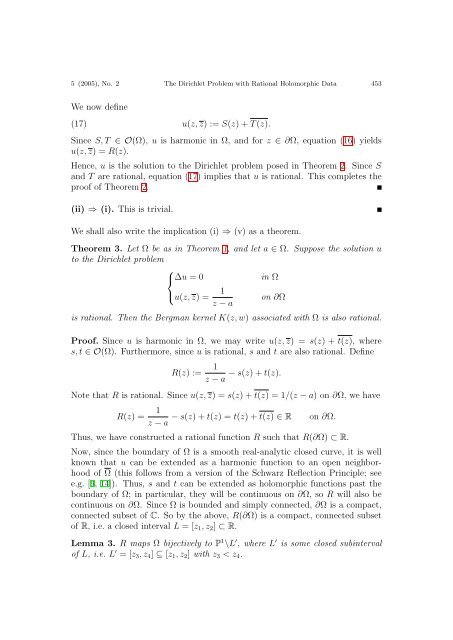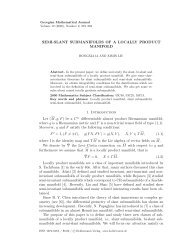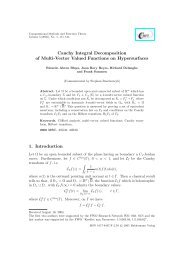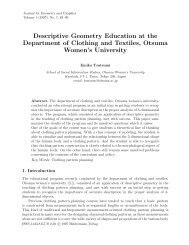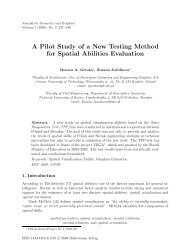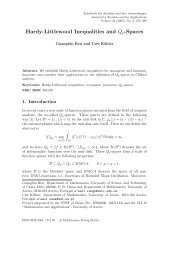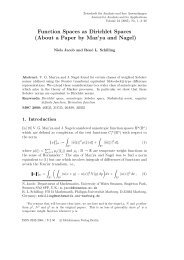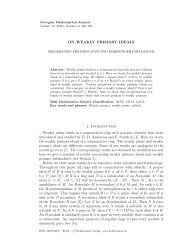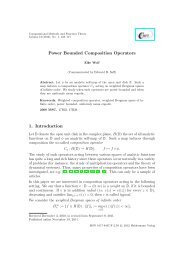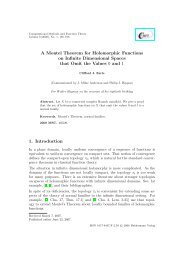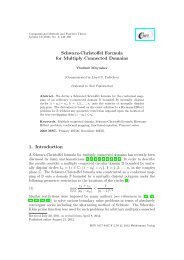On the Solution of the Dirichlet Problem with Rational Holomorphic ...
On the Solution of the Dirichlet Problem with Rational Holomorphic ...
On the Solution of the Dirichlet Problem with Rational Holomorphic ...
Create successful ePaper yourself
Turn your PDF publications into a flip-book with our unique Google optimized e-Paper software.
5 (2005), No. 2 The <strong>Dirichlet</strong> <strong>Problem</strong> <strong>with</strong> <strong>Rational</strong> <strong>Holomorphic</strong> Data 453<br />
We now define<br />
(17) u(z, z) := S(z) + T (z).<br />
Since S, T ∈ O(Ω), u is harmonic in Ω, and for z ∈ ∂Ω, equation (16) yields<br />
u(z, z) = R(z).<br />
Hence, u is <strong>the</strong> solution to <strong>the</strong> <strong>Dirichlet</strong> problem posed in Theorem 2. Since S<br />
and T are rational, equation (17) implies that u is rational. This completes <strong>the</strong><br />
pro<strong>of</strong> <strong>of</strong> Theorem 2.<br />
(ii) ⇒ (i). This is trivial.<br />
We shall also write <strong>the</strong> implication (i) ⇒ (v) as a <strong>the</strong>orem.<br />
Theorem 3. Let Ω be as in Theorem 1, and let a ∈ Ω. Suppose <strong>the</strong> solution u<br />
to <strong>the</strong> <strong>Dirichlet</strong> problem<br />
⎧<br />
⎨∆u = 0<br />
in Ω<br />
⎩u(z, z) = 1 on ∂Ω<br />
z − a<br />
is rational. Then <strong>the</strong> Bergman kernel K(z, w) associated <strong>with</strong> Ω is also rational.<br />
Pro<strong>of</strong>. Since u is harmonic in Ω, we may write u(z, z) = s(z) + t(z), where<br />
s, t ∈ O(Ω). Fur<strong>the</strong>rmore, since u is rational, s and t are also rational. Define<br />
R(z) := 1 − s(z) + t(z).<br />
z − a<br />
Note that R is rational. Since u(z, z) = s(z) + t(z) = 1/(z − a) on ∂Ω, we have<br />
R(z) = 1 − s(z) + t(z) = t(z) + t(z) ∈ R<br />
z − a<br />
on ∂Ω.<br />
Thus, we have constructed a rational function R such that R(∂Ω) ⊂ R.<br />
Now, since <strong>the</strong> boundary <strong>of</strong> Ω is a smooth real-analytic closed curve, it is well<br />
known that u can be extended as a harmonic function to an open neighborhood<br />
<strong>of</strong> Ω (this follows from a version <strong>of</strong> <strong>the</strong> Schwarz Reflection Principle; see<br />
e.g. [9, 14]). Thus, s and t can be extended as holomorphic functions past <strong>the</strong><br />
boundary <strong>of</strong> Ω; in particular, <strong>the</strong>y will be continuous on ∂Ω, so R will also be<br />
continuous on ∂Ω. Since Ω is bounded and simply connected, ∂Ω is a compact,<br />
connected subset <strong>of</strong> C. So by <strong>the</strong> above, R(∂Ω) is a compact, connected subset<br />
<strong>of</strong> R, i.e. a closed interval L = [z 1 , z 2 ] ⊂ R.<br />
Lemma 3. R maps Ω bijectively to P 1 \L ′ , where L ′ is some closed subinterval<br />
<strong>of</strong> L, i.e. L ′ = [z 3 , z 4 ] ⊆ [z 1 , z 2 ] <strong>with</strong> z 3 < z 4 .


